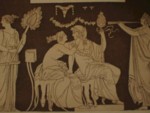[For details click on the images]

Fig.1 Flag
fan after Titian
(from Blondel, Bibliog. No.85)

Fig.3 Greco-Roman
vase painting
Figures 2-4 of this page are designed by P. Avril, from O. Uzanne, L'éventail
Eros & Amor: love iconography on fans
1.
Introduction
The European fan was never solely the useful instrument to relieve the
heat, but was considered jewelry and status symbol from its early days.
The fan was part of the outfit of the aristocratic lady from Renaissance
times onwards (approx. 1400), sometimes also of men. The fan of this
period appears as hand screen, fixed feather fan or flag fan. Its main
role consisted in attracting attention to its wearer's gestures and
allure. It is no coincidence that the flag fan – its form and name reminds
of military standards – was used by unmarried women or brides, as well
as courtesans of the Cinque- and Seicento Venice. Paintings depicting
this custom are Titian's portrait of his daughter Lavinia as bride (Dresden,
Germany, Gemäldegalerie) and Vecellio's drawings of traditional
costumes of 1590. Elizabeth I. of England was well aware that the most
beautiful part of her body were her hands. Consequently, she emphasized
them, using fans at all occasions. There is hardly a portrait of hers
without a feather fan, in later years she also holds folding fans.
The emergence of the folding fan towards the end of the 16th century
started the undisputed victory of the fan. In addition to the graceful
handling of the fan, a new element emerged and made the fan the focus
for centuries to come: the surprise effect. A tiny movement of the hand
("un instrument qui s'estendoit et se replioit en y donnant seulement
un coup de doigt…", from "L'isle des hermaphrodites"
1588 as quoted in Blondel) suffices to turn a stick into a semi-circle
full of wonderful pictures, thus depicting miniature paintings with
fashionable topics such as scenes of ancient mythology. These scenes,
apart from allowing for lesser dressed figures, served as a pretext
for the omnipresent, all-dominating topic: Eros and love. Thus, the
woman wearing a fan decided which allegoric view (and message) she wanted
to convey to the onlookers and thus, how she wanted to be seen by them.
2.
Mythological Scenes:
Ovid's "Metamorphoses" were amongst the favourite literature
from medieval times onwards. The stories of Greek and Roman gods and
goddesses were one of the few sources of education (apart from the Bible
and some "modern" writers such as Torquato Tasso). Therefore,
it can be assumed that women and men alike knew the protagonists and
their symbolic significance. Renaissance and baroque paintings show
frequently mythological scenes that often served as inspiration for
fan painters:
Zeus and Danae: Zeus (Latin: Jupiter), the unfaithful
husband of Hera (Juno) was often seduced by the beauty of the female
sex. In this particular case, he appears as gold rain, falling on Danae.
Zeus often uses devious disguises to achieve his adulterous goal (a
cloud for Io, a bull for Europa, a swan for Leda). From the 16th century
onwards, Danae is often depicted as relining nude (similar to Venus),
but in earlier times she personified chastity and opened the interpretation
towards Christian moralism: as a prefiguration of Mary's announcement
(see p.71, "Antique gods and heroes", lexicon of painting,
2003, Berlin).

